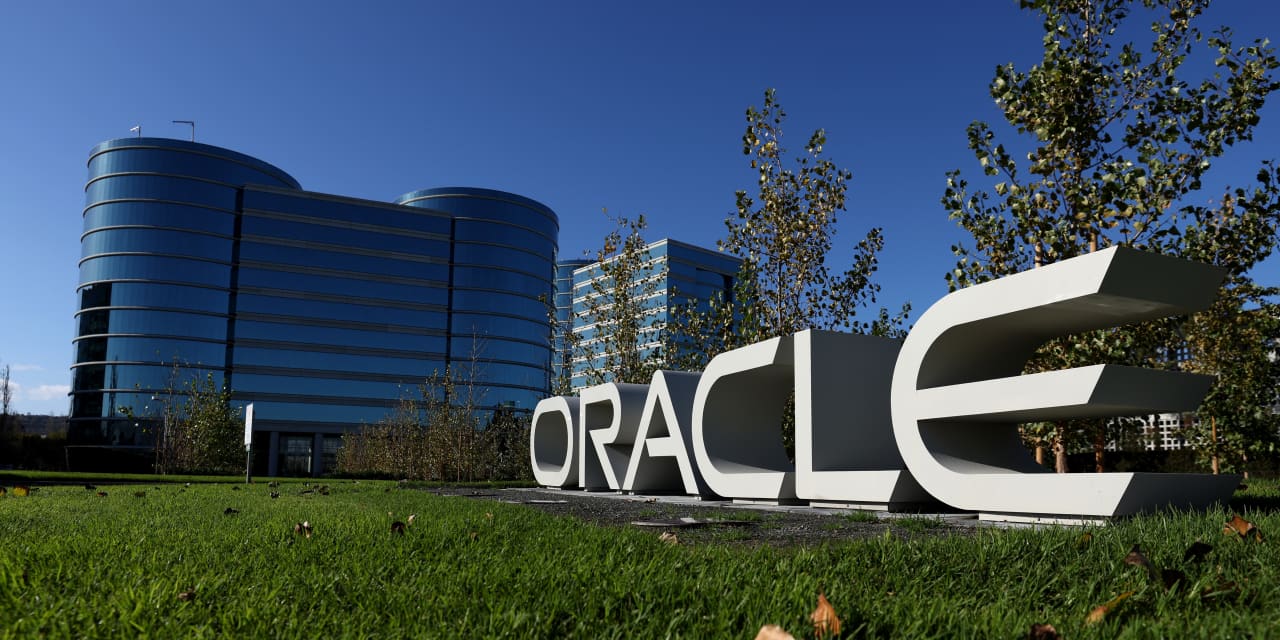Oracle
shares were heading lower after the enterprise software giant posted earnings and guidance that fell short of investor expectations.
The stock slipped 5% after the report and ahead of the company’s post-earnings call with investors, and then fell further after the company provided November quarter guidance, broadening the loss to more than 8%. In premarket trading Tuesday, shares were down nearly 10%.
For the fiscal first quarter ended Aug. 31, Oracle (ticker: ORCL) reported revenue of $12.45 billion, about in line with consensus, up 9% from a year ago, and 8% higher adjusted for currency. The company’s guidance for the quarter had called for 8% to 10% growth in constant currency. Adjusted profits were $1.19 a share, four cents above the Wall Street consensus at $1.15 a share, and above the guidance range of $1.12 to $1.16 a share. Under generally accepted accounting principles, Oracle earned 86 cents a share in the quarter.
Oracle said cloud revenue was $4.6 billion, up 30% from a year ago; that includes 17% growth in cloud application revenue to $3.1. billion, and 66% growth in cloud infrastructure revenue, to $1.5 billion.
The company said Fusion Cloud ERP, the company’s enterprise software for larger enterprises, was up 21% to $800 million, while NetSuite Cloud ERP, similar software for smaller companies, was up 21% to $700 million.
“Is Generative AI the most important new computer technology ever? Maybe!,” Oracle Chairman and CTO Larry Ellison said in the earnings statement. “Self-driving cars, molecular drug design, voice user interfaces—billions of dollars are being invested in AI. As of today, AI development companies have signed contracts to purchase more than $4 billion of capacity in Oracle’s Gen2 Cloud. That’s twice as much as we had booked at the end of Q4.”
Ellison asserted that Oracle can train AI models at twice the speed and less than half the cost of other clouds.
Oracle stock has rallied more than 50% this year on growing expectations that its Oracle Cloud Infrastructure business will get a boost from generative AI workloads. It has outperformed
Microsoft
(MSFT), widely considered one of the most important AI software players, by 10 percentage points.
For the November quarter, Oracle sees revenue up 5% to 7%, or 3% to 5% in constant currency. Excluding the company’s recently acquired Cerner healthcare software business, Oracle sees growth of 8% to 10%, or 6% to 8% adjusted for currency.
Total cloud revenue excluding Cerner is expected to grow 29% to 31%, or 27% to 29% in constant currency. Oracle sees profits for the quarter of between $1.30 and $1.34 a share. Street consensus estimates had called for revenue of $13.3 billion, up 8%, with profits on an adjusted basis of $1.34 a share.
On the call, Oracle CEO Safra Catz said the company remains committed to its previous FY 2026 financial target of at least $65 billion in revenue.
On the company’s last earnings call, Catz said her early read on Oracle’s May 2024 fiscal year was for unprecedented cloud demand, with growth on par or better than fiscal 2023.
Oracle continues to move its legacy customers to cloud-based versions of its flagship database software and its suite of enterprise applications, including NetSuite and Fusion.
But the Oracle story is driven by the Oracle Cloud—known as OCI—and the outlook for the company’s role in AI. Among other things, it has benefited from a strong relationship with
Nvidia
(NVDA), which has given Oracle a generous allocation of GPU chips that it uses to offer AI computing services to customers.
Oracle will hold a meeting with analysts next week in connection with its annual Oracle Cloud World user conference. The company has also announced a joint press conference with Microsoft this Thursday that will feature both Ellison and Microsoft CEO Satya Nadella, and which will focus on their work together on cloud computing applications.
Write to Eric J. Savitz at [email protected]
Read the full article here







